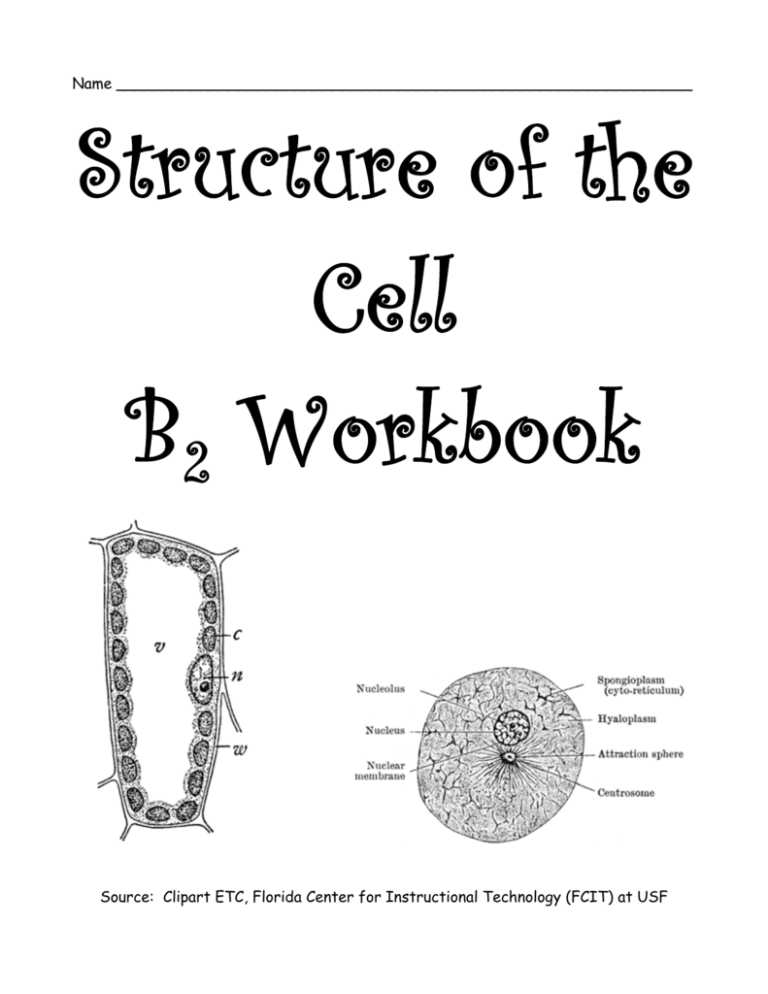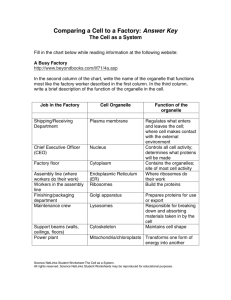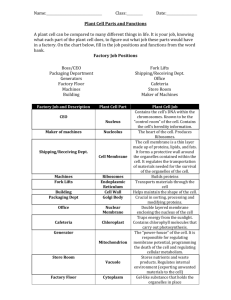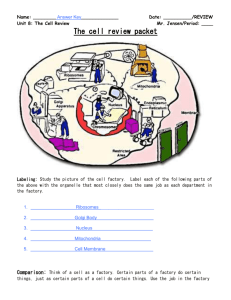B2 Workbook - Mrscienceut.net
advertisement

Name _____________________________________________________________ Structure of the Cell B2 Workbook Source: Clipart ETC, Florida Center for Instructional Technology (FCIT) at USF To complete this set of assignments and, move on to the next set of assignments, you must: Select and complete two (2) assignments. Assignment Completed Complete Cell City Project Complete Comparing the Cell to a Factory Complete Travel Brochure for a Cell Complete What is Cell Theory? Complete Cell Organelle Reference Book Successfully complete the unit assessment with a minimum proficiency level of 3. Cell-City Project Materials Paper Colored Pencils Construction paper Glue Science textbook Purpose In this activity, you will compare cell organelles and functions to those of a working city. Safety Concerns: None Procedure Floating around in the cytoplasm are small structures called organelles. Each one carries out a specific function necessary for the cell to survive. Imagine the cell as a miniature city. The organelles represent companies, places or parts of the city because they each have similar jobs. Below are the descriptions of important parts of the Cell City. City Limits - control what goes in and out of the city. Road System - Allows for movement throughout the city. City Hall - Controls all the activities of the city. City Auditor - Stores all the records of the city and passes them on as the city grows. City Planning Office - A place in the city hall where plans are made for the construction of the city. Construction Company - Builds structures for the city. Delivery Van - delivers products made at the construction company to other locations in the city. Food Processing Plant - Processes large quantities of food entering the city into smaller packages that can be used more easily. Warehouse - Stores materials needed by the city. Power Company - Produces energy for the city. Solar Power Plant – Uses the sun’s energy to produce power for the city. 1 As you move through your worksheet, see if you can match the important parts of the city listed above to the specific organelles found in cells. Be sure to write neatly, and in complete sentences. ONLY after you have completed the worksheets, get an 11” x 17”, and sketch, color (only use colored pencils), and label a city. Each part of the city will be labeled with its name and the name of the cell organelle that has a similar function. On your drawing, identify what each part of your city is and which organelle it represents. Cell City Project Worksheets 1. The nucleus is a large, round/oval structure usually located near the center of the cell. It is the control center for all the activities of the cell. i) What company or place does the nucleus resemble in a Cell City? _____________________________________________________________ ii) Why do you think so? _____________________________________________________________ _____________________________________________________________ 2. The cell membrane is a thin, flexible envelope that surrounds the cell. It allows the cell to change shape and controls what goes into and out of the cell. i) What company or place does the cell membrane resemble in a Cell City? _____________________________________________________________ ii) Why do you think so? _____________________________________________________________ _____________________________________________________________ 2 3. The endoplasmic reticulum consists of a network of tube-like passageways that proteins from the ribosomes are transported through. i) What company or place does the endoplasmic reticulum resemble in a Cell City? _____________________________________________________________ ii) Why do you think so? _____________________________________________________________ _____________________________________________________________ 4. The ribosomes are small grain-like bodies made mostly of RNA and produced in the nucleolus. Proteins are constructed at the ribosomes. i) What company or place do the ribosomes resemble in a Cell City? _____________________________________________________________ ii) Why do you think so? _____________________________________________________________ _____________________________________________________________ 5. The nucleolus is a small, dense object fond in the middle of the nucleus. It makes the RNA for the cell. i) What company or place does the nucleolus resemble in a Cell City? _____________________________________________________________ ii) Why do you think so? _____________________________________________________________ _____________________________________________________________ 3 6. The jelly-like area between the nucleus and the cell membrane is called the cytoplasm. It helps organelles move throughout the cell. i) What company or place does the cytoplasm represent in a Cell City? _____________________________________________________________ ii) Why do you think so? _____________________________________________________________ _____________________________________________________________ 7. The mitochondria are tiny bean-shaped structures in the cytoplasm with a smooth outer membrane, and a greatly folded inner membrane. They supply the energy for the cell by transforming sugars into energy. i) What company or place do the mitochondria resemble in a Cell City? _____________________________________________________________ ii) Why do you think so? _____________________________________________________________ _____________________________________________________________ 8. The chromosomes are rod-shaped bodies found in the nucleus. They are made of DNA and protein. They contain all the information to run the cell. They also pass on the hereditary traits of the cell to new cells. i) What company or place do the chromosomes resemble in a Cell City? _____________________________________________________________ ii) Why do you think so? _____________________________________________________________ _____________________________________________________________ 4 9. The chloroplast is an oval, green structure found in the cytoplasm. It contains chlorophyll. It captures the sun’s energy and uses it to produce sugars in a process called photosynthesis. i) What company or place do the chloroplasts resemble in a Cell City? _____________________________________________________________ ii) Why do you think so? _____________________________________________________________ _____________________________________________________________ 10. The lysosomes are small round structures found in the cytoplasm. They contain digestive enzymes that break down large food particles in to sugars and other simple substances. i) What company or place do the lysosomes resemble in a Cell City? _____________________________________________________________ ii) Why do you think so? _____________________________________________________________ _____________________________________________________________ 11. The vacuole is a large, round sac found in the cytoplasm. It stores water, food, wastes, or other materials needed by the cell. i) What company or place does the vacuole resemble in a Cell City? _____________________________________________________________ ii) Why do you think so? _____________________________________________________________ _____________________________________________________________ 5 Comparing the Cell to a Factory (modified from A Busy Factory, http://www.beyondbooks.com/lif71/4a.asp) Imagine a busy factory making the latest must-have toy. Whether they make bicycles, cell phones, or hot air balloons, most factories are set up the same way. All factories have outside walls that protect and support them and inside walls that create different work areas. They usually have a production line where a product is put together and an executive department that decides what product is made. A finishing department processes and prepares the product for shipping, and a packaging department wraps the product. In addition, a factory has a receiving department that brings in the parts it needs to make its product, a communications department that allows it to contact suppliers, and a power plant that provides the energy it needs to run. Finally, a custodial staff keeps everything clean and in good working order. Cells are similar to factories. To stay alive and function properly, cells have a division of labor similar to that found in factories. All eukaryotic cells are composed of a plasma membrane, a nucleus, and cytoplasm. These structures can be compared with a factory's departments. The Plasma Membrane What if you needed to find a job in the factory? What could you do? If you do not have any manufacturing skills, and you are not management material, you would probably be placed in an entry-level position. Perhaps you'd be assigned to the warehouse. Here, you would be responsible for shipping and receiving. A factory requires a constant supply of raw materials, as well as a way to send out the finished product. This department is usually located along an outside wall of the factory. Working here, you would be one of the factory's contacts with the outside world. You might take a job as a receptionist and sit at a desk near the front door of the factory. A phone would allow you to contact anyone else in the building. Also, all incoming and outgoing calls would go through you. As a receptionist, you may speak for the factory and allow it to communicate with other people and businesses. 6 Maybe you wouldn't want to lift heavy crates in the warehouse or answer phones. Another possibility might be to take a job with the security department. Security personnel are posted at every entrance to the building. You would be responsible for checking ID cards and admitting only those individuals who belong in the factory. Mail, reception, and security are separate departments in a real factory. But in a cell, these jobs are all performed by the plasma membrane. The Nucleus In a factory, the chief executive officer controls everything that happens. What would it be like to have this job in a cell factory? You would have your own office (which would be nice) but you would also have many responsibilities. You would need to keep track of all the blueprints kept in your office. And you would tell the workers which products to build and when to build them. The cell factory contains a large inventory of blueprints dating all the way to its founding. Some of these blueprints are out of date, and some are for parts and products that are no longer made. Part of your job would entail sorting through everything, finding the correct blueprints, copying them, and sending the copies out to the assembly line at the correct time. When the factory gets too large, it is difficult to run properly; thus, another factory must be built. To prepare for this, you have to provide the new factory with its own set of all the blueprints. Sounds a bit daunting? Now you may have a better appreciation for what the nucleus does in the cell. The Cytoplasm The real work of the cell occurs in the cytoplasm, the cell's "factory floor." The term "cytoplasm" refers to everything between the cell membrane and the nuclear membrane. It consists mostly of water, salts, some proteins, and many small structures called organelles (or little organs). These structures perform several different functions for the cell which generally fall under the categories of production, maintenance, and energy transformation. This tour 7 of the cell includes several stops on the "factory floor." Let's start with the production team. The Endoplasmic Reticulum In a factory, the assembly of parts takes place on the factory floor. The highly skilled craftspeople who assemble these components sit hour after hour at their stations, plugging away at their work. These workers are highly paid because they can read plans and use that information to make different kinds of products. Each one of them has his or her own work area, surrounded by tools. These workers do not create the product designs; rather, they read the plans sent from the executive department. The cell has its own assembly line and workers. Within the cytoplasm is a series of large, flattened membranes that fold back and forth on each other and have a very large surface area. This collection of membranes is called the ENDOPLASMIC RETICULUM, or ER – the cell’s assembly line. The ER stretches from the nuclear membrane to the plasma membrane. It serves as a pathway through the cytoplasm, as a support structure for the attachment of other organelles, and as a workstation for the ribosomes. The ER can be divided into two parts: the rough ER and the smooth ER. The rough ER has ribosomes attached to it and provides a surface along which the process of protein assembly can occur. The smooth ER does not have ribosomes and is much more tubular in appearance. In some human cells, the smooth ER produces steroids; in others it regulates calcium levels. In a process that scientists still don't understand, the rough ER manufactures the membranes of the smooth ER. The Ribosomes Ribosomes, the factory workers that build proteins, are manufactured by the nucleolus. They consist of two separate subunits: a large, lower subunit and a small, upper subunit. Ribosomes attach to the rough ER. Now let's take a look at how final processing occurs. The Golgi Body What happens to all the products that are built on the assembly line of a factory? The final touches are put on them in the finishing and packing department. 8 Workers in this part of the plant are responsible for making minor adjustments to the finished products. They inspect the products for flaws; clean them of any extra material added during their manufacture, wrap them, and target them for packing. The Golgi apparatus performs all the finishing and packing in the cell. Lysosomes and The Cytoskeleton Any factory needs a good maintenance crew to keep everything orderly, to get rid of the trash, and to take apart and throw away old machinery. The maintenance crew also functions as a second line of defense. If someone gets past the security guard at the front door, it is usually the maintenance crew who catches the trespassers and chases them out. In a cell, the role of building maintenance crew is filled by the lysosomes. Lysosomes The word "lysosome" is Latin for "kill body." This is a very colorful description for some of the most unusual organelles in the cell. LYSOSOMES are organelles produced by the Golgi apparatus that contain powerful protein digesting enzymes. Maintenance crews do not get the glory of chief executive officers, or even that of the production worker, but they serve a very important purpose. Without lysosomes, the cell would accumulate too much junk and would not be able to function for very long. Support Beams There is another major department in a cell factory, although it usually isn't given a department name in a regular factory. It's the walls, floors, and ceilings of a factory. Within the cytoplasm of the cell are many protein fibers that act as support structures. In a cell, the cytoskeleton supports the cell. Mitochondria and Chloroplasts Any factory needs power to operate. The power must be in a usable form. Most factories have power plants in which generators burn fuel to produce heat. This heat energy is used to make steam, which is then used to make electricity. 9 Building proteins is the main function of cells. But for this to occur, a cell must have an energy source, and that energy must be in a form that the cell can use. The mitochondrion and the chloroplast are the two organelles responsible for energy transformation (neither organelle truly produces energy). Like our factory's power plant, mitochondria and chloroplasts transform one form of energy to another. Comparing the Cell to a Factory Worksheet Fill in the chart below while reading information given you in the handout. • In the second column of the chart, write the name of the organelle that functions most like the factory worker described in the first column. • In the third column, write a brief description of the function of the organelle in the cell. Job in the Factory Cell Organelle Function of the Organelle Shipping/Receiving Department Chief Executive Officer (CEO) Factory Floor Assembly Line (where workers do their work) Workers on the Assembly Line Finishing/Packaging Department 10 Maintenance Crew Support Beams (walls, ceilings, floors) Power Plant (2 answers) Travel Brochure for a Cell For this assignment, you are required to produce a travel brochure that describes a plant or animal cell as if it were a large exhibit/ amusement park. You must UaccuratelyU describe, draw (to the best of your ability), and explain the following organelles (attractions) and their functions. For all Cells: Endoplasmic Reticulum Golgi Body Mitochondria Vacuole Cell Membrane Cytoplasm Ribosome Nucleus Lysosome For Plant Cells, you must include: Chloroplast Cell Wall Humor and creativity are strongly encouraged. Your travel brochure should persuade visitors to take the next exit and visit the "incredible!, amazing!, and unbelievable!" sights 11 of an animal or plant cell. For example, visitors might want to "visit the ribosomes, located just outside the nucleus, and watch as proteins are synthesized RIGHT BEFORE YOUR VERY EYES!" Be creative with your descriptions, such as "be sure to visit the Golgi center inside the gift shop, and have your purchases gift wrapped for you before you leave." What is Cell Theory? Cell Theory is an important part of biology. Your assignment is to learn more about Cell Theory. Imagine that you work for the Unemployment Office or a “headhunter” agency as an employment consultant. One of the scientists who contributed to modern cell theory is out of work and needs some help writing his resume. It is your job to help him do this so that he can find a job. (See a sample resume on page 14.) __________________________________________________________________ __________________________________________________________________ __________________________________________________________________ __________________________________________________________________ __________________________________________________________________ __________________________________________________________________ __________________________________________________________________ __________________________________________________________________ __________________________________________________________________ __________________________________________________________________ __________________________________________________________________ __________________________________________________________________ 12 __________________________________________________________________ __________________________________________________________________ __________________________________________________________________ __________________________________________________________________ __________________________________________________________________ __________________________________________________________________ __________________________________________________________________ __________________________________________________________________ __________________________________________________________________ __________________________________________________________________ My Cell Organelle Reference Booklet Your assignment is to make a cell organelle reference booklet. Your booklet will consist of the following: A front cover title “My Cell Organelle Reference Booklet.” A blank back cover. This is where your name will go. Using your Cell Table handout, you will make one page for each organelle. Each page will include: o A drawing of the organelle, colored with colored pencils. Use your text and/or the Kids Discover Cells magazine for pictures of the organelles. o A detailed description of what this organelle does in the cell. o ALL OF THIS WILL BE DONE NEATLY. IF IT IS NOT DONE NEATLY, IT WILL BE RETURNED TO BE REDONE. When you are done, you will punch two holes along the side of your booklet and hold it together by tying the pages together using yarn. (Make sure the yarn is not too tight. If it is, you won’t be able to turn the pages.) 13 Jimmi Carter 1823 Stackhouse Ln. Akron, OH 44301 JimmiCarter@cvgreat.com Home (817) 555-0021 Office (817) 555-9010 __________________ Objective A tenure track position in a well estabilished sociology department, which will allow for adequate time and funding to be directed toward research. Summary of Achievements Rhodes Scholar 1988 - 1990: Awarded two years of post-graduate study at Oxford University. Pursued the M.Phil in Social Sciences. Gene Landis Award for Outstanding Teaching 1995 & 1997: Selected by the student body of York College. Experience 1999 - Present Assistant Professor, Sociology - University of Pittsburgh, Pittsburgh, PA Taught such notable courses as "Intro to Sociology", "Sociology of Inequality", and "The McDonaldization of Society". 1995 - 1998 Lecturer, York College, York, PA Education Ph.D, Sociology, 1994 Penn State University, State College, PA Specialization: Global inequality, sociology of marriage M.Phil, Social Sciences, 1990 Oxford College, Oxford, UK B.A. Sociology, Literature 1988 Cornell University Ithaca, NY Selected Publications "Building More Prisons: Retribution or Rehabilitation?", American Journal of Sociology. Worthington Press, June 1995 "Big Mac Nation", published in The Globalization Reader. Bretton-Woods Press. August, 1997. 14








